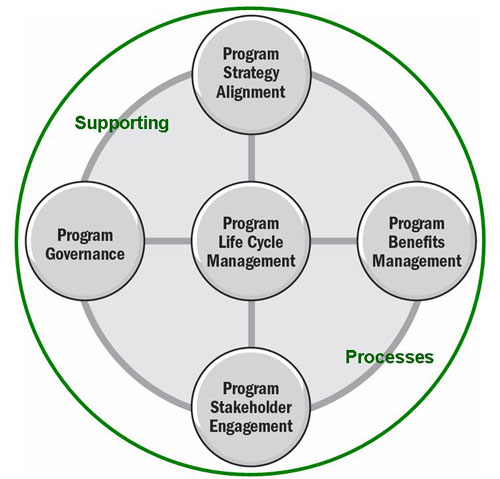The most noticeable thing about the new Standard for Program Management – Third Edition is that is has gone on a major diet! The 2nd Edition was 271 page long (plus appendix), the 3rd Edition is less than half the size at 106 pages plus appendix. Unfortunately the price has not moved in the same direction.
The Standard still provides a detailed understanding of program management and promotes efficient and effective communication and coordination among various project management groups. The major updates include:
- Program Life Cycle has been assigned its own chapter for the third edition to provide the details of the unique set of elements that makes up the program management phase.
- The third edition highlights the full scope of program management and clarifies the supporting processes that complete the delivery of programs in the organizational setting.
- A more detailed definition of program management within an organization is provided, including the fundamental differences between project management and program management.
The major focus of the revision seems to be removing a lot of the ‘project management’ information that is found in the PMBOK® Guide and focusing on the role of program management in organisations, the unique characteristics of program management work and the role of the program manager. A shift from process to principle, that is aligned with the Program Management Role Delineation Study that forms the basis for the PgMP examination.
The framework in the Third Edition is:
- Introduction
- Program Management Performance Domains
- Program Strategy Alignment
- Program Benefits Management
- Program Stakeholder Engagement
- Program Governance
- Program Life Cycle Management
- Program Management Supporting Processes
The relationship between the Program Management Performance Domains that makes up the bulk of the standard is illustrated below.
In addition to the core standard, Appendix X4 on Program Management Competencies, and X5 on Program Management Artefacts are very succinct and useful.
A couple of shortcomings in this version of the standard are firstly the limited recognition of the different type of program that organisations run. The PMI standard is very much centred on the ‘strategic program’ defined in the GAPPS typology discussed in our White Paper Defining Program Types. In particular the GAPPS ‘Operational Program’ typology has been largely ignored in the PMI standard.
The other is the classic confusion between the Enterprise level executive management responsibilities that are critical for the support and oversight of the work of the Program Manager and Organisational Governance, typical of documentation produced by working managers. What the standard describes as ‘governance’ is the critical management responsibilities of senior executives to adequately support oversight and manage the process of ‘program management’. Governance is the process of oversighting the whole management system, that is performed by the ‘governing body’ which is the Board of Directors in most commercial organisations and their equivalent in other types of organisation – governors govern, managers manage! For more on this critical distinction see: WP1084 Governance Systems & Management Systems. The contents of the ‘governance’ section are good, just miss-labelled.
Summary
Overall this is a significantly improved standard – a lot of duplication and redundancy has been removed, and the key functions and processes of program management and what organisations need to do at the enterprise level to support programs are well though through and laid out. This new standard is available in Australia from: http://www.mosaicprojects.com.au/Books.html#PMI




